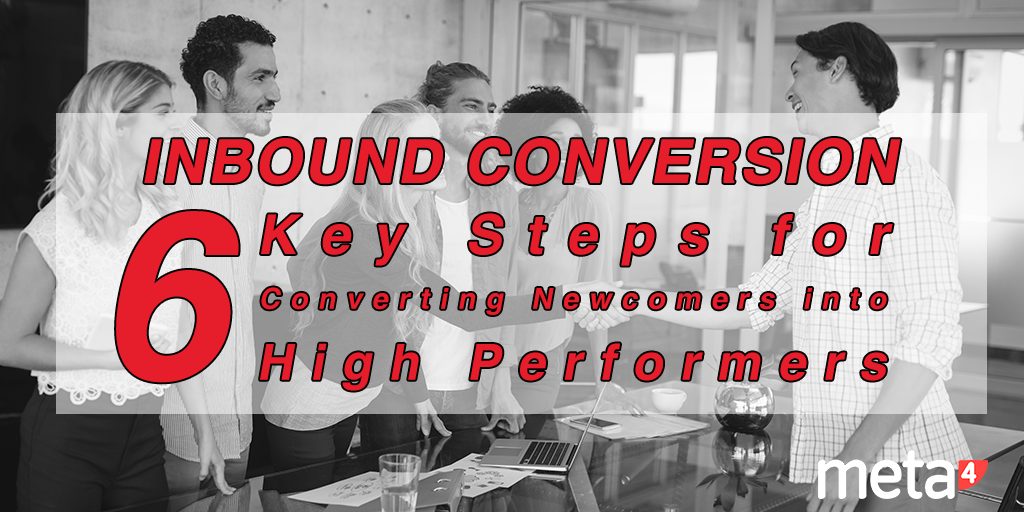Behind every great athlete is a masterful coach that inspires the athlete to evolve into the strongest performer they can become. Cathy Engelbert, CEO Deloitte
Inbound Conversion engages the newcomer to become a high performer, just as the masterful coach inspires a great athlete and brings out their potential and best results. Inbound Conversion is the second phase of the previously discussed Inbound Talent framework that takes a new proactive person- or employee-centric approach to HR management based on Inbound Marketing principles. Inbound Conversion follows on from Inbound Recruitment, the first phase that seeks to establish a relationship with the right people to cover organizational needs, as discussed in the ebook, “Inbound Recruiting: Attract to Delight”.
Why is Inbound Conversion necessary?
Once you have the right people identified, then the art of converting newcomers into high performers becomes the next challenge of any organization. Overcoming talent attraction issues gives way to the more complicated challenges of talent retention, first with new hires. Recent workforce insights studies by Equifax indicate that about 40% of new hires decide to change jobs within the first six months in their new post.
What connects the Attract phase to the Convert phase, or Inbound Recruitment to Inbound Conversion, is the onboarding process. Inbound Recruiting terminates with the selection of the right candidate; Inbound Conversion starts with the newcomer who is none other than this newly hired candidate. The goal of Inbound Conversion is for the newcomer to assimilate into the culture, get up to speed and become a productive member of the organization as soon as possible, and for the organization to not lose this new talent before six months or even afterwards. This involves strategic onboarding and planning ahead to ensure talent retention and return on investment of these newcomers through successful conversion into high performers.
This inevitably requires careful preparation and definition of your conversion strategy. Regardless of the preparation involved, here we outline the steps for any conversion plan defined.
6 Steps for Implementing Newcomer Conversion
-
Set up a strategic onboarding process to fast track a new employee’s engagement with the organization.
Give your onboarding process a strategic focus that anticipates and plans to keep new employees engaged to the company as long as possible, ensuring their commitment. This means doing whatever it takes to develop and support this newcomer.
-
Encourage interpersonal relations to better assimilate the newcomer into the corporate culture
If we improve relationships among employees from the start, we will create a pleasant work environment with a more transparent communication and boost higher levels of productivity. It is up to the Human Resources department to define the strategy and culture for nurturing these relationships.
-
Implement continuous performance assessment to keep newcomer on the right path
HR is better off undertaking continuous performance assessments right from a new employee’s first day. It is far easier to spot things as they occur and provide immediate feedback or take immediate actions to help the newcomer assimilate into the culture and do a better job.
-
Maintain an ongoing relationship with the newcomer to know their opinions and thoughts
It is vital to keep in constant touch with new employees; while losing a candidate is a problem, losing a key employee can directly affect an organization’s business performance. HR needs to know what is going on in a new employee’s mind, while the new employee must feel able to share opinions and issues with HR.
-
Promote transparency in the organization for better communication
Employees who are kept informed and understand their role in a company’s strategy are more likely to trust the organization. Transparency favours this trust. To align employee objectives with the organizational ones, it is necessary to share them openly. A transparent communication policy coming from HR will encourage and nurture open conversations among employees.
-
Detecting potential for growth in employees
For this step, it becomes easier to detect the potential of your new hires for growth, so they become even better performers through all the information gathered from assessments, feedback and shared communication.
HR Technology as an enabler for successful Inbound Conversion
Logically, the right kind of HR Technology in place will facilitate the implementation of a company’s conversion plan. It makes it easier to execute each step smoothly with the right kind of onboarding, performance management and development functionalities. Of course, just as in online marketing conversion, one also needs suitable HR technology and indicators to measure the success of your newcomer conversion.
Conclusion
Ultimately, Inbound Conversion is about getting the most out of your new employees, while they get the most out of your organization and their job experience as soon as possible to become high performers.
To find out more about the preparation, the steps and how to measure the success of conversion, download the new ebook.






